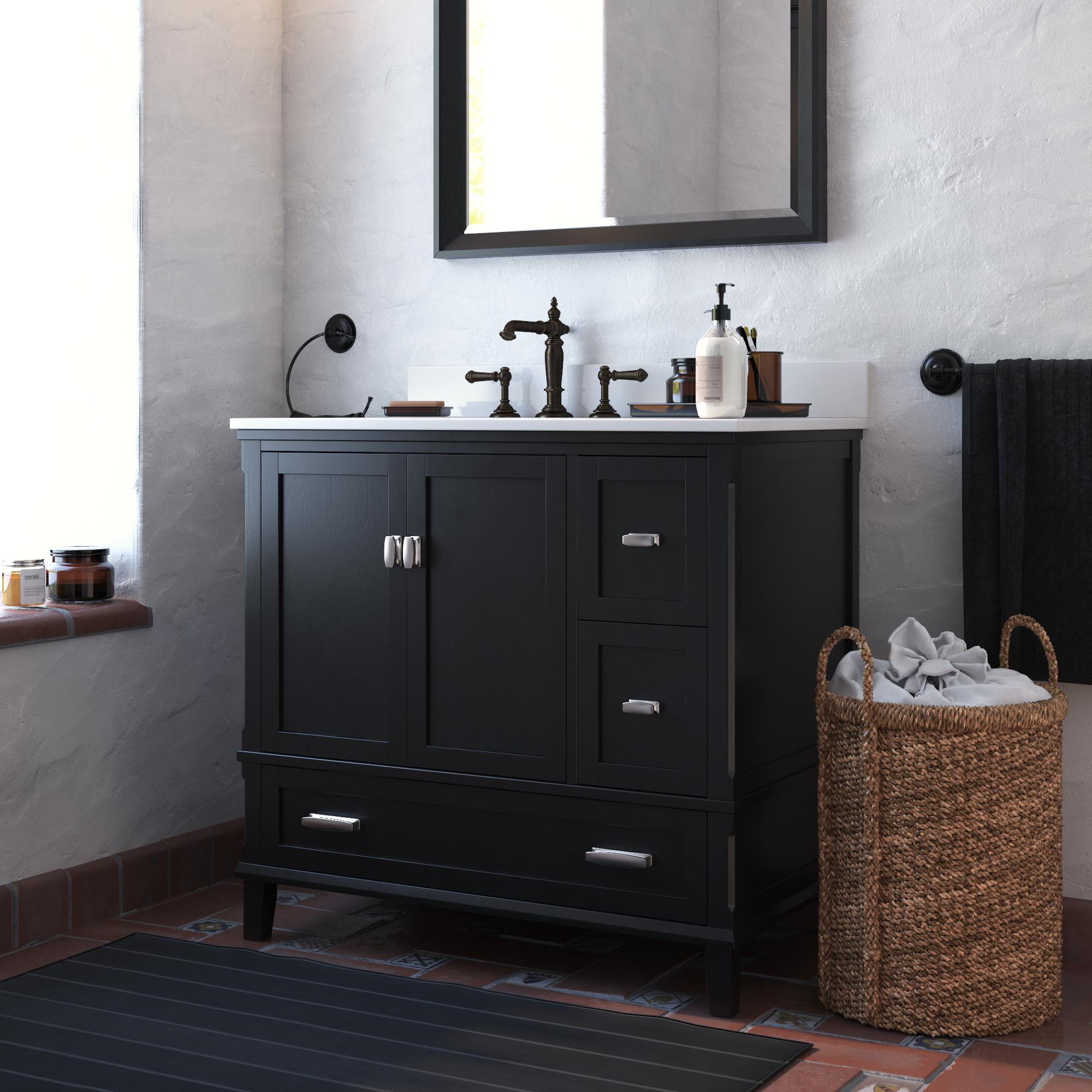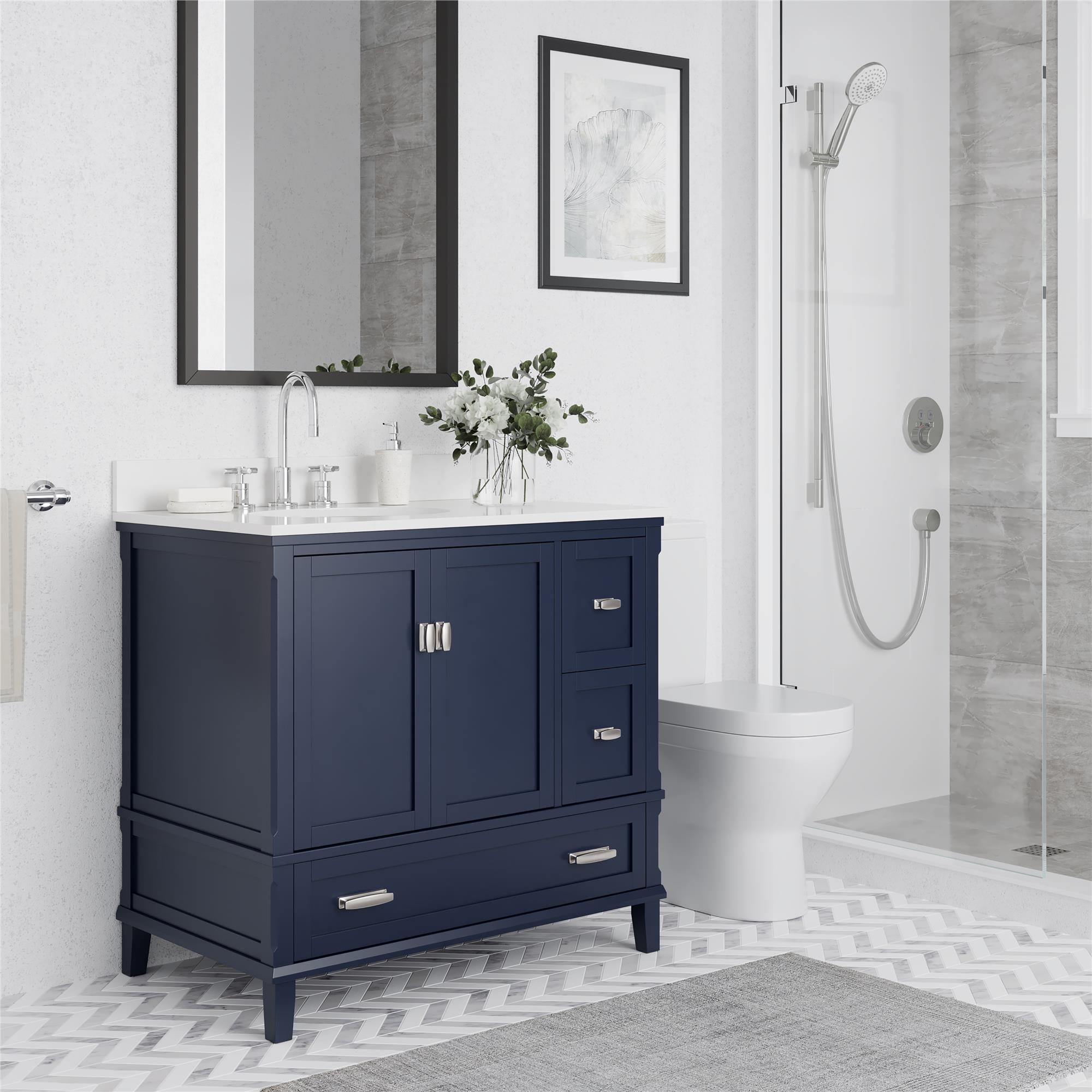The Appeal of a 36-Inch Floating Bathroom Vanity: 36 Inch Floating Bathroom Vanity

A 36-inch floating bathroom vanity offers a stylish and practical solution for small bathrooms. This type of vanity provides ample storage space while creating a sense of openness and spaciousness.
Benefits of a 36-Inch Floating Vanity for Small Bathrooms
Floating vanities are especially beneficial for small bathrooms because they maximize floor space. By eliminating the need for legs, floating vanities visually enlarge the room and create a more open and airy feel.
Aesthetic Advantages of Floating Vanities, 36 inch floating bathroom vanity
Floating vanities provide a modern and sleek aesthetic that complements contemporary and minimalist bathroom designs. The clean lines and absence of bulky legs create a streamlined and sophisticated look. The elevated design also allows for a visual separation between the vanity and the floor, adding a sense of lightness and airiness to the bathroom.
Materials and Finishes for 36-Inch Floating Vanities
Floating vanities are available in a wide range of materials and finishes to suit various bathroom styles and preferences. Popular choices include:
- Wood: Walnut, oak, and cherry are popular choices for their durability and natural beauty.
- Laminate: Laminate is a cost-effective option that offers a variety of colors and patterns.
- Acrylic: Acrylic is a durable and water-resistant material that is easy to clean and maintain.
- Stone: Natural stone, such as granite or marble, adds a luxurious touch to the bathroom.
Design Tips for Incorporating a 36-Inch Floating Vanity into a Bathroom Layout
When incorporating a 36-inch floating vanity into a bathroom layout, consider the following tips:
- Choose a Vanity Size that Fits the Space: A 36-inch vanity is a good option for small bathrooms, but ensure it fits comfortably within the available space, allowing for adequate walking room.
- Maximize Storage Space: Floating vanities often have drawers and cabinets that can be used to store toiletries, towels, and other bathroom essentials.
- Choose the Right Sink: Consider the size and shape of the sink when selecting a floating vanity. Undermount sinks are a popular choice for floating vanities, as they create a seamless look.
- Add Lighting: Proper lighting is essential for a functional and aesthetically pleasing bathroom. Consider adding under-cabinet lighting or a vanity mirror with integrated lighting.
- Consider the Backsplash: A backsplash behind the floating vanity can protect the wall from splashes and add a decorative element to the bathroom.
Choosing the Right 36-Inch Floating Vanity

A 36-inch floating vanity offers a stylish and space-saving solution for your bathroom, but choosing the right one requires careful consideration of several factors. You’ll need to assess your needs and preferences to ensure the vanity fits your bathroom’s design and functionality.
Storage Options
The amount of storage you require will influence your choice of vanity. 36-inch floating vanities offer a range of storage options, from simple open shelves to drawers and cabinets.
- Open Shelves: Offer easy access to items but lack privacy. Ideal for displaying decorative items or storing towels.
- Drawers: Provide concealed storage for toiletries, medications, and other personal items. Choose vanities with soft-close drawers for smooth operation and longevity.
- Cabinets: Offer ample storage space for larger items like hair dryers or styling tools. Consider vanities with adjustable shelves for greater flexibility.
Sink Styles
The sink style can significantly impact the vanity’s aesthetics and functionality. 36-inch floating vanities typically accommodate various sink types.
- Undermount Sinks: Seamlessly integrated into the countertop, offering a sleek and modern look. Easy to clean and maintain.
- Vessel Sinks: Sit atop the countertop, adding a decorative element. Available in a wide array of materials and designs.
- Semi-recessed Sinks: Partially embedded into the countertop, providing a balance between functionality and aesthetics.
Countertop Materials
The countertop material significantly influences the vanity’s durability, maintenance requirements, and aesthetic appeal. Popular countertop materials for 36-inch floating vanities include:
| Material | Durability | Maintenance | Aesthetic Appeal |
|---|---|---|---|
| Granite | High | Regular sealing | Natural, elegant |
| Quartz | Very high | Low | Modern, versatile |
| Marble | Moderate | High | Classic, luxurious |
| Laminate | Moderate | Low | Budget-friendly, wide range of colors and patterns |
Installing a 36-Inch Floating Vanity

Installing a 36-inch floating vanity can be a rewarding DIY project, adding a modern touch to your bathroom. However, it requires careful planning and execution to ensure stability and a professional finish. This guide provides a step-by-step process for installing a floating vanity, addressing potential challenges, and offering tips for a successful installation.
Tools and Materials
A successful floating vanity installation requires a specific set of tools and materials. Having these readily available will streamline the process and prevent delays.
- Floating vanity cabinet: Choose a 36-inch vanity that complements your bathroom’s style and storage needs.
- Installation brackets: These are usually included with the vanity, but ensure you have the correct type and quantity for your specific model.
- Stud finder: To locate wall studs for secure mounting of the vanity.
- Level: Essential for ensuring the vanity is installed straight and level.
- Measuring tape: To accurately determine distances and cut materials.
- Pencil: For marking installation points on the wall.
- Drill with appropriate bits: To drill pilot holes and secure the brackets.
- Screwdriver: For attaching the vanity to the brackets.
- Caulk gun: For sealing gaps between the vanity and the wall.
- Silicone caulk: To prevent water damage and create a clean finish.
- Safety glasses: Protect your eyes from debris while drilling.
- Work gloves: Provide protection and a better grip while handling tools.
Preparing the Wall
Before mounting the vanity, ensure the wall is properly prepared. This step is crucial for a secure and stable installation.
- Locate wall studs: Use a stud finder to identify the studs behind the wall where the vanity brackets will be mounted. Studs provide the strongest support for the vanity, ensuring stability.
- Mark installation points: Use a pencil to mark the location of the brackets on the wall, ensuring they are level and aligned with the vanity. Refer to the manufacturer’s instructions for the exact spacing and placement of the brackets.
- Clear obstacles: Remove any existing fixtures or obstacles that may interfere with the installation. This includes electrical outlets, light switches, or pipes.
- Check for existing plumbing: If you are installing a vanity with a sink, ensure the existing plumbing is compatible and accessible. You may need to adjust or relocate pipes for proper connection.
Installing the Brackets
- Drill pilot holes: Drill pilot holes at the marked locations on the wall. These holes will help prevent the screws from splitting the wallboard when securing the brackets.
- Secure the brackets: Use appropriate screws to attach the brackets to the wall. Ensure the screws are long enough to penetrate the wall stud for maximum stability. If you are mounting the brackets to drywall, use drywall anchors for additional support.
- Double-check level: After attaching the brackets, use a level to ensure they are perfectly horizontal and aligned. Adjust the brackets if necessary.
Attaching the Vanity
- Align the vanity: Carefully lift the vanity and align it with the brackets. Ensure the vanity is level and centered before attaching it to the brackets.
- Secure the vanity: Attach the vanity to the brackets using the provided screws or bolts. Tighten the screws or bolts securely, but avoid overtightening, which can damage the vanity.
Finishing Touches
- Caulk the gaps: Use silicone caulk to seal any gaps between the vanity and the wall. This will prevent water damage and create a clean, finished look.
- Install the sink: If you are installing a vanity with a sink, attach the sink to the countertop according to the manufacturer’s instructions. Ensure the faucet is connected to the plumbing and functional.
- Add hardware: Install any necessary hardware, such as drawer pulls, knobs, or towel bars. This will complete the vanity installation and make it ready for use.
Troubleshooting
- Uneven walls: If the walls are uneven, shims can be used to level the vanity before attaching it to the brackets.
- Heavy vanity: For heavier vanities, additional support may be needed, such as using a thicker wallboard or adding extra brackets.
- Difficult access: If you have limited access to the wall studs, consider using toggle bolts or other heavy-duty anchors to secure the brackets.
Pre-Installation Checklist
- Have all necessary tools and materials ready: Ensure you have all the tools and materials listed above before starting the installation.
- Read the manufacturer’s instructions: Carefully review the installation instructions provided with the vanity. This will ensure you understand the specific requirements for your model.
- Measure twice, cut once: Double-check all measurements and cuts to avoid mistakes that can lead to a misaligned or unstable vanity.
- Prepare the work area: Clear the area around the installation site of any obstacles or debris. This will prevent accidents and make the installation process easier.
- Have a helper: It is recommended to have a helper to assist with lifting and positioning the heavy vanity, especially if you are working alone.
